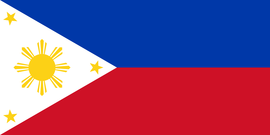
菲律宾共和国(以下简称菲律宾),面积29.97万平方公里。人口约1亿200万。首都大马尼拉市。马来族占全国人口的85%以上。有70多种语言,国语是以他加禄语为基础的菲律宾语,英语为官方语言。国民约85%信奉天主教,4.9%信奉伊斯兰教,华人多信奉佛教。
菲律宾位于亚洲东南部,北隔巴士海峡与中国台湾省遥遥相对,南和西南隔苏拉威西海、巴拉巴克海峡与印度尼西亚、马来西亚相望,西濒南中国海,东临太平洋。共有大小岛屿7000多个,其中吕宋岛、棉兰老岛、萨马岛等11个主要岛屿占全国总面积的96%。海岸线长约18533公里。属季风型热带雨林气候,高温多雨,湿度大,台风多。年均气温27℃,年降水量2000~3000毫米。
菲律宾全国划分为吕宋、维萨亚和棉兰老三大部分。设有首都地区、科迪勒拉行政区、棉兰老穆斯林自治区等18个地区,下设81个省和117个市。
菲律宾属于出口导向型经济,对外部市场依赖较大。第三产业在国民经济中地位突出,农业和制造业也占相当比重。1997年爆发的亚洲金融危机对菲冲击不大,但其经济增速再度放缓。杜特尔特总统执政后,加大对基础设施建设和农业的投入,推进税制改革,经济保持高速增长,但也面临通货膨胀高企、政府财力不足、腐败严重影响经济等问题。
2019年国内生产总值约3546亿美元,2019年人均国内生产总值约3262美元,2018年国内生产总值增长率5.9%。
气候方面,由于地理位置的关系,菲律宾全国都是热带雨林气候。菲律宾的平均气温为26摄氏度。另一个特点是强台风,通常发生在6月至11月。降雨量可能每个月都有,而且全年都不一样。一般6月至10月有大雨,而12月至5月由于来自东北部的信风,几乎没有降雨。季风是一种起源于西南的多雨的风。在台风季节,菲律宾的许多岛屿很容易遭受严重的洪水和破坏。菲律宾北部岛屿发生台风的频率高于南部岛屿。
The Republic of the Philippines (hereinafter referred to as the Philippines), with an area of 299700 square kilometers and a population of about 122 million, is the capital city of Manila. The Malay people account for more than 85% of the national population. There are more than 70 languages. The national language is Filipino based on Tagalog, and English is the official language. About 85% of the people believe in Catholicism, 4.9% believe in Islam, and most Chinese believe in Buddhism.
Philippines is located in Southeast Asia. The North Strait is far away from Taiwan, China. The South and southwest are separated by Sura weste sea, the Indonesia River and the Malaysia, and the west coast of the South China Sea. There are more than 7000 large and small islands, including 11 major islands such as Luzon, Mindanao and SAMA, accounting for 96% of the total area of the country. The coastline is about 18533 kilometers long. It belongs to monsoon tropical rain forest climate, with high temperature and rain, high humidity and many typhoons. The average annual temperature is 27 ℃, and the annual precipitation is 2000 ~ 3000 mm.
The Philippines is divided into three parts: Luzon, visaya and Mindanao. It has 18 regions, including the capital region, Cordillera administrative region and Mindanao Muslim autonomous region, with 81 provinces and 117 cities.
The Philippines is an export-oriented economy and is highly dependent on external markets. The tertiary industry plays a prominent role in the national economy, and agriculture and manufacturing also account for a considerable proportion. The Asian financial crisis in 1997 had little impact on the Philippines, but its economic growth slowed down again. After President duterte took office, he increased investment in infrastructure construction and agriculture, promoted tax reform, and maintained rapid economic growth. However, he also faced problems such as high inflation, insufficient government financial resources, corruption and serious impact on the economy.
The GDP in 2019 is about 354.6 billion US dollars, the per capita GDP in 2019 is about 3262 US dollars, and the GDP growth rate in 2018 is 5.9%.
In terms of climate, due to its geographical location, the Philippines has a tropical rain forest climate. The average temperature in the Philippines is 26 degrees Celsius. Another feature is a strong typhoon, which usually occurs from June to November. Rainfall may occur every month and vary throughout the year. Generally, there is heavy rain from June to October, while there is almost no rain from December to may due to the trade wind from the northeast. Monsoon is a rainy wind originated in the southwest. During the typhoon season, many islands in the Philippines are vulnerable to serious floods and damage. The frequency of typhoons in the northern islands of the Philippines is higher than that in the southern islands.













